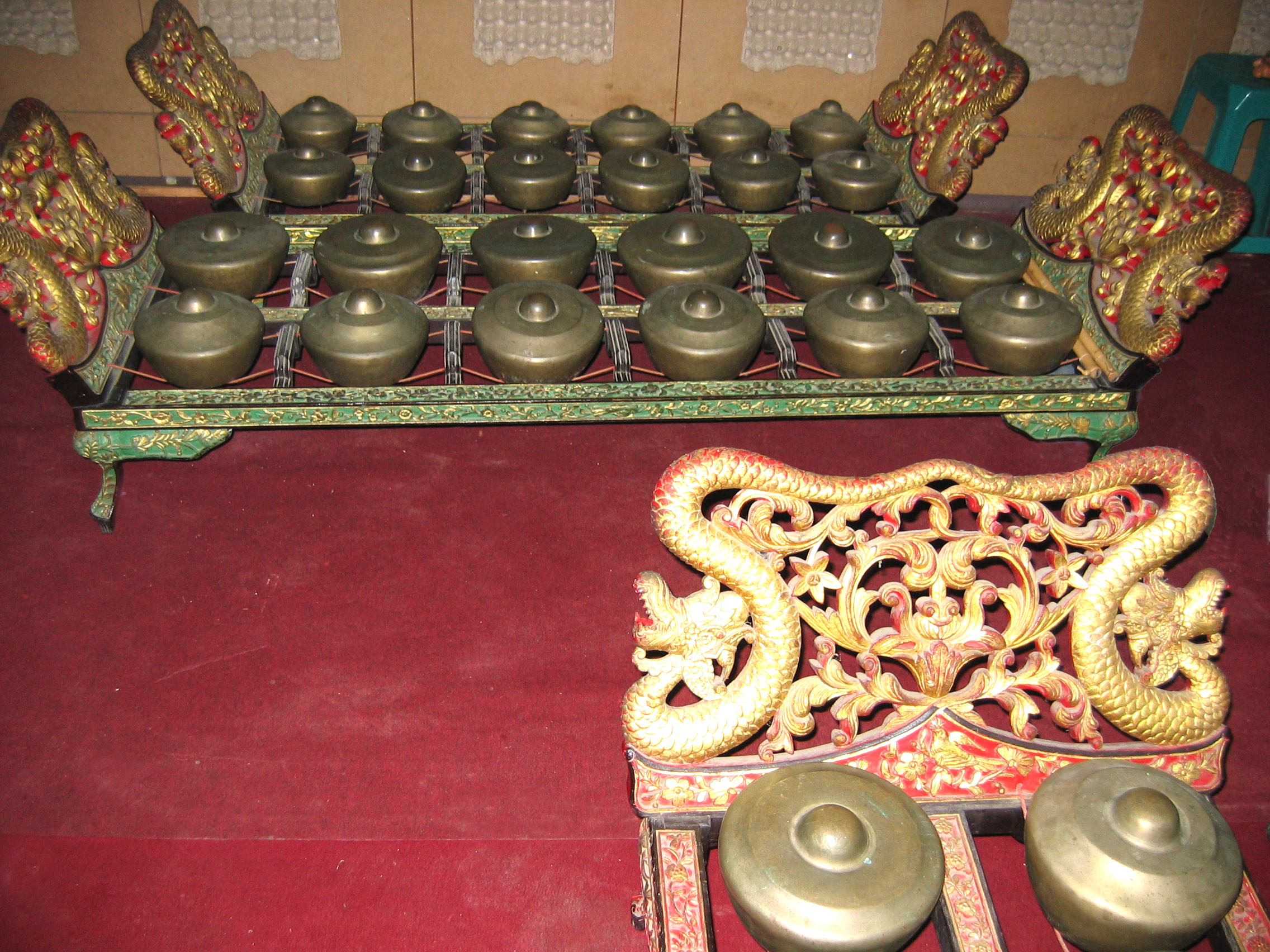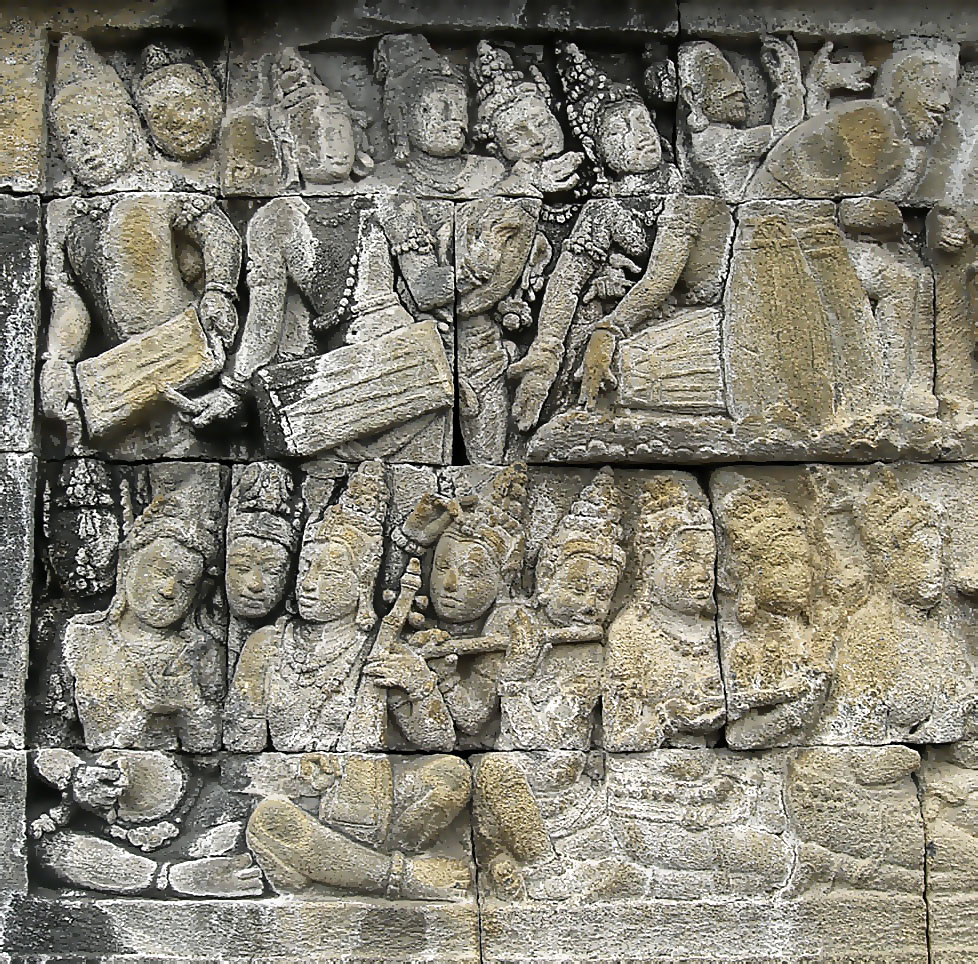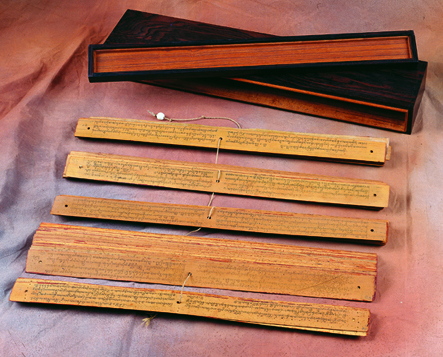|
Slenthem
The slenthem (also slentem or gender panembung) is an Indonesian metallophone which makes up part of a Javanese gamelan orchestra. The slenthem is part of the gendér family. It consists of a set of bronze keys comprising a single octave: there are six keys when playing the slendro scale and seven when playing the pelog. These keys are suspended by leather cords over individual bamboo tube resonators in a wooden frame, which are cut so that the placement of the bamboo's node causes the functional length of the resonator to be shorter for higher notes. The instrument is played by striking the keys with a mallet, called a ''tabuh'', which has a short handle and a thin wooden disk edged in cloth or rubber. One hand is left free to dampen notes. It is a low-pitched instrument with a softer sound than the saron demung. Like the saron barung and demung, it generally plays the most basic form of the melody (balungan) in a composition. However it also sometimes uses techniques simi ... [...More Info...] [...Related Items...] OR: [Wikipedia] [Google] [Baidu] |
Gamelan Gadhon
A ''gamelan gadhon'' is an ensemble consisting of the 'soft' instruments of the Javanese gamelan. This can include ''rebab'', '' gendér'', '' gendér panerus'', voice, ''slenthem'', ''suling'', ''siter'', gong, ''kempul'', ''kenong'' and ''kendhang''. The instruments and their functions The ''rebab'', a two-stringed fiddle, is the melodic leader of the ensemble. The ''rebab'' player signals changes between sections of a piece, and to a new piece. The '' gendér'' is a tube-resonated metallophone with fourteen keys suspended by string above metal tubes. The ''gendér'' plays improvisatory patterns called ''cengkok'' which link one ''seleh'' note to the next. Each pattern can be played in many ways and the musician chooses how to play each one at the time, according to the style of the piece, the ''pathet'', the ''irama'', and other musical considerations. The ''slenthem'' is a low-pitched tube-resonated metallophone played with a large padded mallet held in one hand, with the ot ... [...More Info...] [...Related Items...] OR: [Wikipedia] [Google] [Baidu] |
Gamelan Instruments
Gamelan () ( jv, ꦒꦩꦼꦭꦤ꧀, su, ᮌᮙᮨᮜᮔ᮪, ban, ᬕᬫᭂᬮᬦ᭄) is the traditional ensemble music of the Javanese, Sundanese, and Balinese peoples of Indonesia, made up predominantly of percussive instruments. The most common instruments used are metallophones played by mallets and a set of hand-played drums called ''kendhang/Kendang'', which register the beat. The kemanak (a banana-shaped idiophone) and gangsa (another metallophone) are commonly used gamelan instruments in Bali. Other instruments include xylophones, bamboo flutes, a bowed instrument called a ''rebab'', a zither-like instrument '' siter'' (in Javanese ensemble) and vocalists named '' sindhen'' (female) or '' gerong'' (male).Sumarsam (1998)''Introduction to Javanese Gamelan'' Middletown. Although the popularity of gamelan has declined since the introduction of pop music, gamelan is still commonly played in many traditional ceremonies and other modern activities in Indonesia, both ... [...More Info...] [...Related Items...] OR: [Wikipedia] [Google] [Baidu] |
Bonang
The bonang is an Indonesian musical instrument used in the Javanese gamelan. It is a collection of small gongs (sometimes called "kettles" or "pots") placed horizontally onto strings in a wooden frame (''rancak''), either one or two rows wide. All of the kettles have a central boss, but around it the lower-pitched ones have a flattened head, while the higher ones have an arched one. Each is tuned to a specific pitch in the appropriate scale; thus there are different bonang for pelog and slendro. They are typically hit with padded sticks (''tabuh''). This is similar to the other cradled gongs in the gamelan, the kethuk, kempyang, and kenong. Bonang may be made of forged bronze, welded and cold-hammered iron, or a combination of metals. In addition to the gong-shaped form of kettles, economical bonang made of hammered iron or brass plates with raised bosses are often found in village gamelan, in Suriname-style gamelan, and in some American gamelan. In central Javanese gam ... [...More Info...] [...Related Items...] OR: [Wikipedia] [Google] [Baidu] |
Saron (instrument)
The saron is a musical instrument of Indonesia, which is used in the gamelan. It normally has seven bronze bars placed on top of a resonating frame (''rancak''). It is usually about 20 cm (8 in) high, and is played on the floor by a seated performer. In a pelog scale, the bars often read 1-2-3-5-6-7 across (the number four is not used because of its relation to death) (in kepatihan numbering); for slendro, the bars are 6-1-2-3-5-6-1; this can vary from gamelan to gamelan, or even among instruments in the same gamelan. Slendro instruments commonly have only six keys. It provides the core melody (balungan) in the gamelan orchestra. Varieties Sarons typically come in a number often sizes, from smallest to largest: *Saron panerus (also: peking) *Saron barung (sometimes just saron) *Saron demung (often just called demung) Each one of those is pitched an octave below the previous. The slenthem or slentho performs a similar function to the sarons one octave below the ... [...More Info...] [...Related Items...] OR: [Wikipedia] [Google] [Baidu] |
Gamelan
Gamelan () ( jv, ꦒꦩꦼꦭꦤ꧀, su, ᮌᮙᮨᮜᮔ᮪, ban, ᬕᬫᭂᬮᬦ᭄) is the traditional ensemble music of the Javanese, Sundanese, and Balinese peoples of Indonesia, made up predominantly of percussive instruments. The most common instruments used are metallophones played by mallets and a set of hand-played drums called '' kendhang/Kendang'', which register the beat. The kemanak (a banana-shaped idiophone) and gangsa (another metallophone) are commonly used gamelan instruments in Bali. Other instruments include xylophones, bamboo flutes, a bowed instrument called a ''rebab'', a zither-like instrument '' siter'' (in Javanese ensemble) and vocalists named '' sindhen'' (female) or ''gerong'' (male).Sumarsam (1998)''Introduction to Javanese Gamelan'' Middletown. Although the popularity of gamelan has declined since the introduction of pop music, gamelan is still commonly played in many traditional ceremonies and other modern activities in Indon ... [...More Info...] [...Related Items...] OR: [Wikipedia] [Google] [Baidu] |
Gamelan Gedhé
Gamelan () ( jv, ꦒꦩꦼꦭꦤ꧀, su, ᮌᮙᮨᮜᮔ᮪, ban, ᬕᬫᭂᬮᬦ᭄) is the traditional ensemble music of the Javanese, Sundanese, and Balinese peoples of Indonesia, made up predominantly of percussive instruments. The most common instruments used are metallophones played by mallets and a set of hand-played drums called ''kendhang/Kendang'', which register the beat. The kemanak (a banana-shaped idiophone) and gangsa (another metallophone) are commonly used gamelan instruments in Bali. Other instruments include xylophones, bamboo flutes, a bowed instrument called a ''rebab'', a zither-like instrument ''siter'' (in Javanese ensemble) and vocalists named '' sindhen'' (female) or '' gerong'' (male).Sumarsam (1998)''Introduction to Javanese Gamelan'' Middletown. Although the popularity of gamelan has declined since the introduction of pop music, gamelan is still commonly played in many traditional ceremonies and other modern activities in Indonesia, both ... [...More Info...] [...Related Items...] OR: [Wikipedia] [Google] [Baidu] |
Saron (instrument)
The saron is a musical instrument of Indonesia, which is used in the gamelan. It normally has seven bronze bars placed on top of a resonating frame (''rancak''). It is usually about 20 cm (8 in) high, and is played on the floor by a seated performer. In a pelog scale, the bars often read 1-2-3-5-6-7 across (the number four is not used because of its relation to death) (in kepatihan numbering); for slendro, the bars are 6-1-2-3-5-6-1; this can vary from gamelan to gamelan, or even among instruments in the same gamelan. Slendro instruments commonly have only six keys. It provides the core melody (balungan) in the gamelan orchestra. Varieties Sarons typically come in a number often sizes, from smallest to largest: *Saron panerus (also: peking) *Saron barung (sometimes just saron) *Saron demung (often just called demung) Each one of those is pitched an octave below the previous. The slenthem or slentho performs a similar function to the sarons one octave below the ... [...More Info...] [...Related Items...] OR: [Wikipedia] [Google] [Baidu] |
Gamelan
Gamelan () ( jv, ꦒꦩꦼꦭꦤ꧀, su, ᮌᮙᮨᮜᮔ᮪, ban, ᬕᬫᭂᬮᬦ᭄) is the traditional ensemble music of the Javanese, Sundanese, and Balinese peoples of Indonesia, made up predominantly of percussive instruments. The most common instruments used are metallophones played by mallets and a set of hand-played drums called '' kendhang/Kendang'', which register the beat. The kemanak (a banana-shaped idiophone) and gangsa (another metallophone) are commonly used gamelan instruments in Bali. Other instruments include xylophones, bamboo flutes, a bowed instrument called a ''rebab'', a zither-like instrument '' siter'' (in Javanese ensemble) and vocalists named '' sindhen'' (female) or ''gerong'' (male).Sumarsam (1998)''Introduction to Javanese Gamelan'' Middletown. Although the popularity of gamelan has declined since the introduction of pop music, gamelan is still commonly played in many traditional ceremonies and other modern activities in Indon ... [...More Info...] [...Related Items...] OR: [Wikipedia] [Google] [Baidu] |
Balungan
The ''balungan'' ( jv, skeleton, frame) is sometimes called the "core melody" or, "skeletal melodic outline," of a Javanese gamelan composition. This corresponds to the view that gamelan music is heterophonic: the ''balungan'' is then the melody which is being elaborated. "An abstraction of the inner melody felt by musicians," the ''balungan'' is, "the part most frequently notated by Javanese musicians, and the only one likely to be used in performance."Anderson Sutton, Richard (1991). ''Traditions of Gamelan Music in Java: Musical Pluralism and Regional Identity'', p.xix. Cambridge University. . The group of instruments which play the closest to the ''balungan'' are sometimes also called the ''balungan'', or ''balungan'' instruments. These are the ''saron'' family and the '' slenthem''. In many pieces, they play the ''balungan''. However, they can also elaborate on the parts in a variety of techniques. It is possible that there is no instrument playing the ''balungan'', althoug ... [...More Info...] [...Related Items...] OR: [Wikipedia] [Google] [Baidu] |
Music Of Indonesia
As it is a country with many different tribes and ethnic groups, the music of Indonesia ( id, Musik Indonesia) itself is also very diverse, coming in hundreds of different forms and styles. Every region have its own culture and art, and as a result traditional music from area to area also uniquely differs from one another. For example, each traditional music are often accompanied by their very own dance and theatre. Contemporary music scene have also been heavily shaped by various foreign influences, such as America, Britain, Japan, Korea, and India. The music of Java, Sumatra, Bali, Flores (Lesser Sunda Islands) and other islands have been well documented and recorded, and further research by Indonesian and international scholars is also ongoing. The music in Indonesia predates historical records, various Native Indonesian tribes often incorporate chants and songs accompanied with musical instruments in their rituals. The contemporary music of Indonesia today is also po ... [...More Info...] [...Related Items...] OR: [Wikipedia] [Google] [Baidu] |
Balungan Instruments
The ''balungan'' ( jv, skeleton, frame) is sometimes called the "core melody" or, "skeletal melodic outline," of a Javanese gamelan composition. This corresponds to the view that gamelan music is heterophonic: the ''balungan'' is then the melody which is being elaborated. "An abstraction of the inner melody felt by musicians," the ''balungan'' is, "the part most frequently notated by Javanese musicians, and the only one likely to be used in performance."Anderson Sutton, Richard (1991). ''Traditions of Gamelan Music in Java: Musical Pluralism and Regional Identity'', p.xix. Cambridge University. . The group of instruments which play the closest to the ''balungan'' are sometimes also called the ''balungan'', or ''balungan'' instruments. These are the ''saron'' family and the '' slenthem''. In many pieces, they play the ''balungan''. However, they can also elaborate on the parts in a variety of techniques. It is possible that there is no instrument playing the ''balungan'', althoug ... [...More Info...] [...Related Items...] OR: [Wikipedia] [Google] [Baidu] |



